
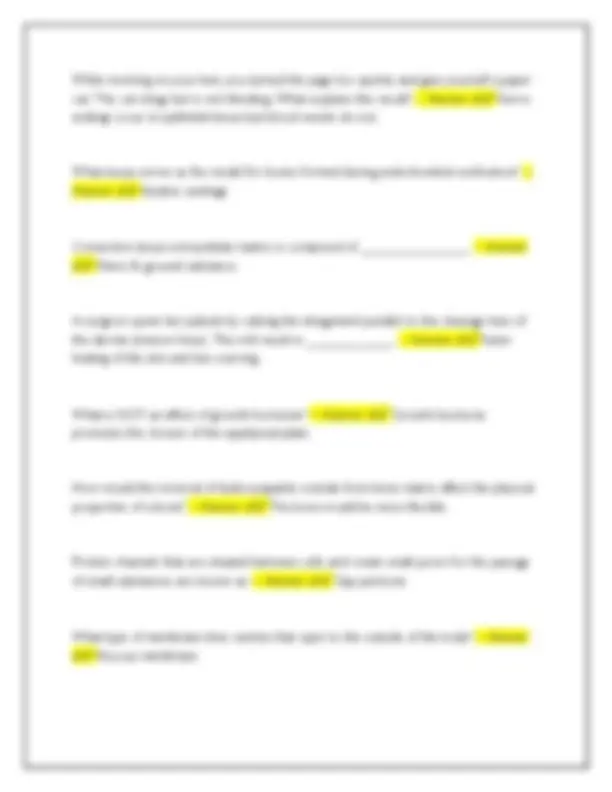
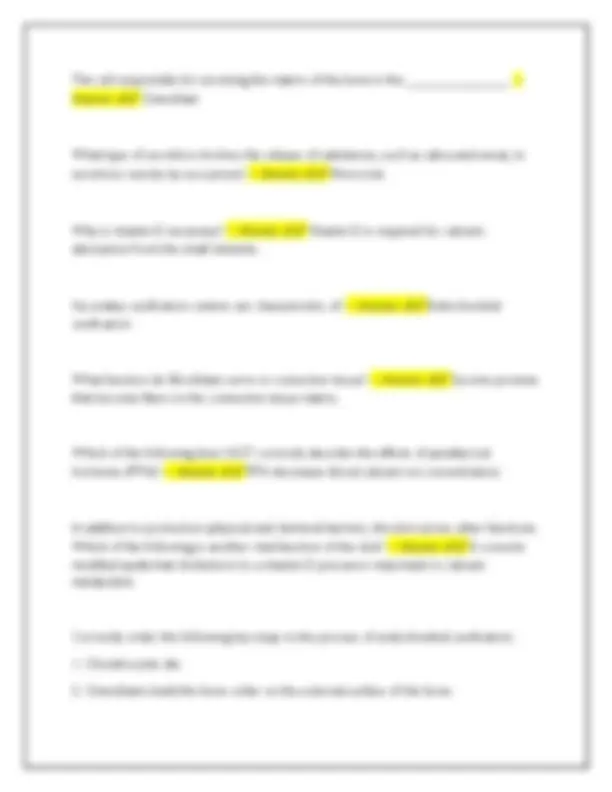
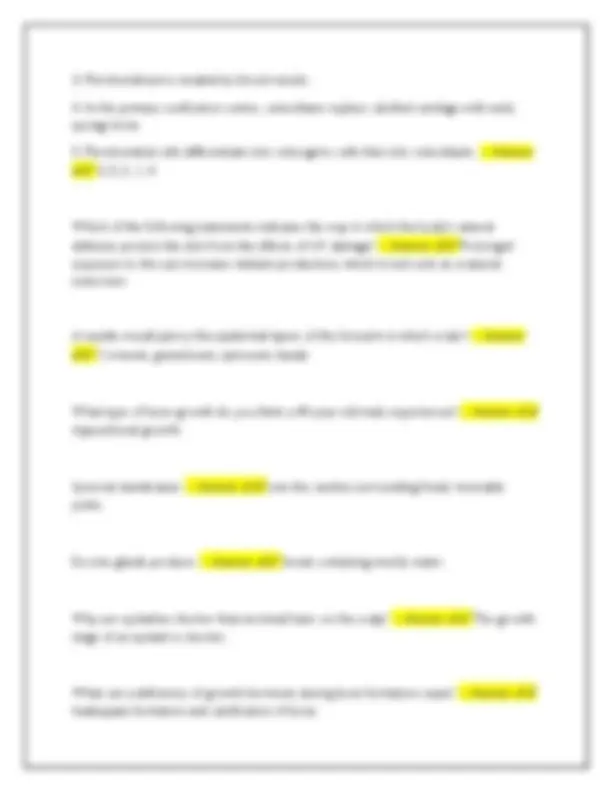
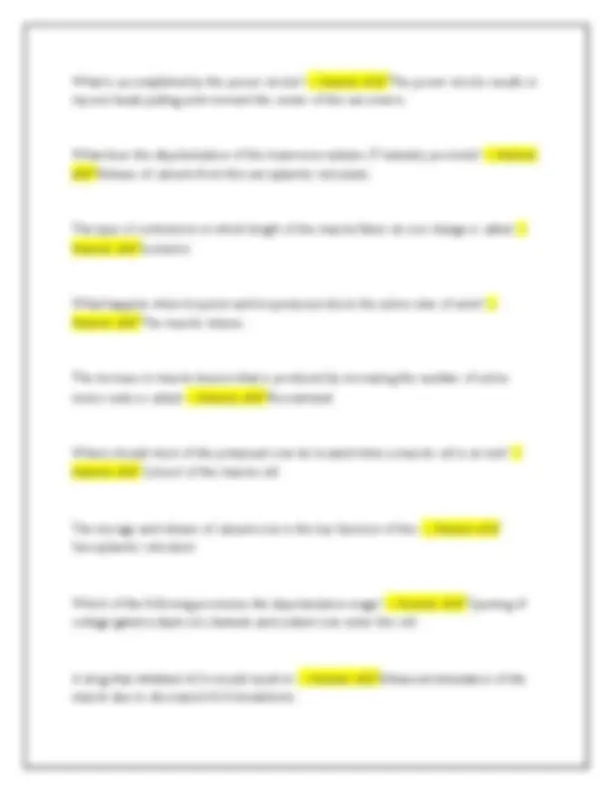
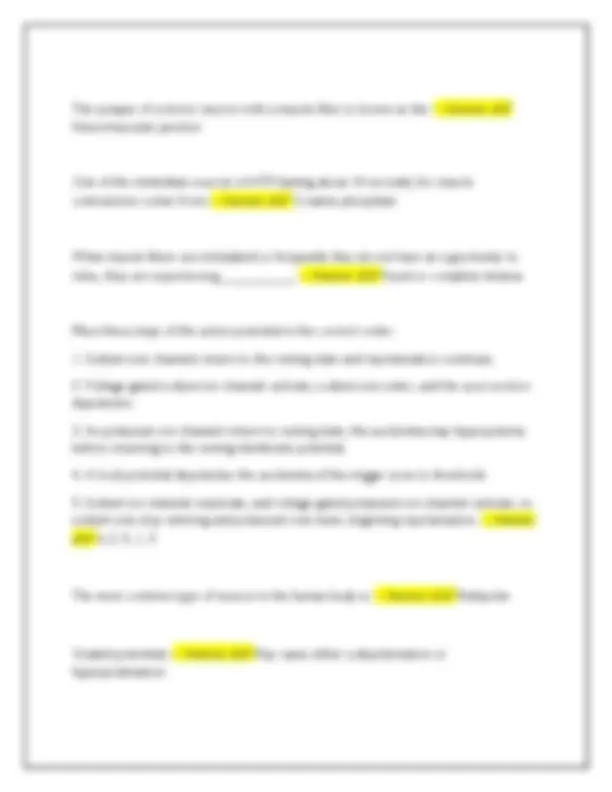
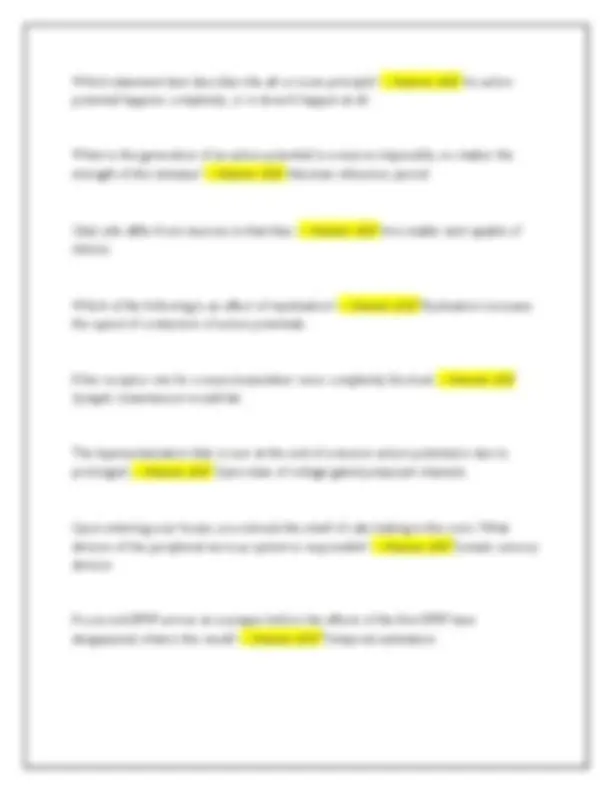
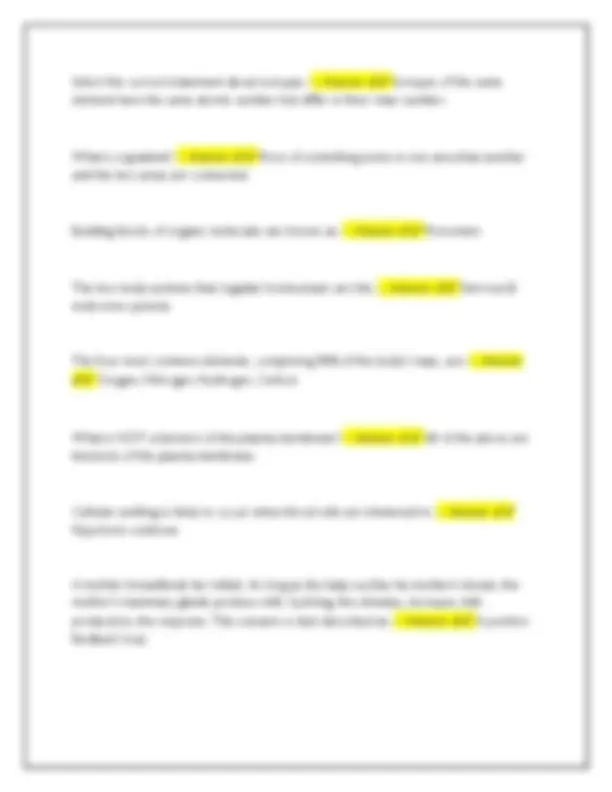
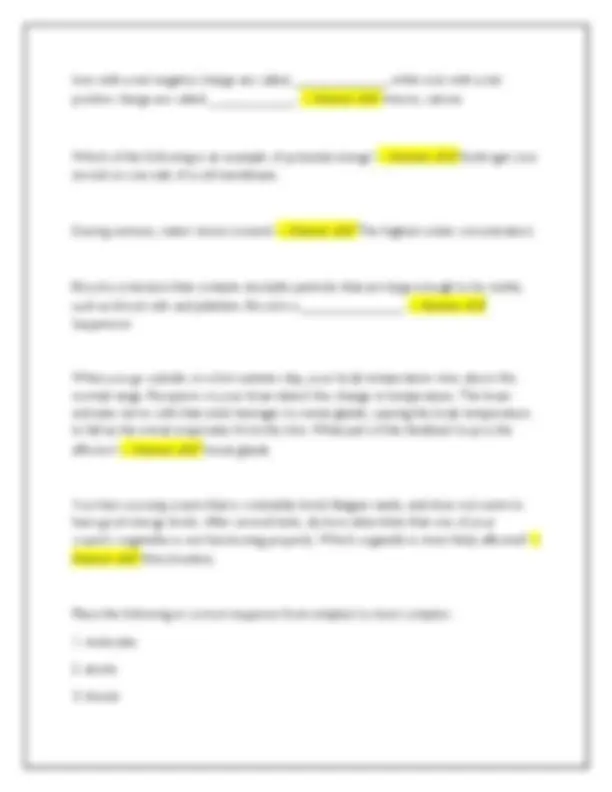
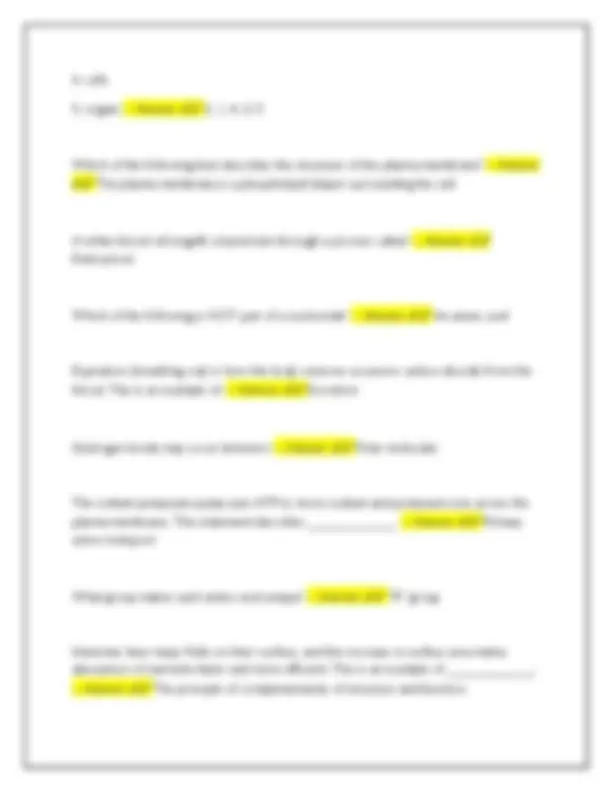


Study with the several resources on Docsity

Earn points by helping other students or get them with a premium plan


Prepare for your exams
Study with the several resources on Docsity

Earn points to download
Earn points by helping other students or get them with a premium plan
Community
Ask the community for help and clear up your study doubts
Discover the best universities in your country according to Docsity users
Free resources
Download our free guides on studying techniques, anxiety management strategies, and thesis advice from Docsity tutors
A series of questions and answers related to introductory biology, specifically covering topics such as cell biology, anatomy, and physiology. It includes questions about cell structures, tissue types, bone formation, muscle contraction, and membrane transport. Designed to test understanding of key concepts and processes in biology, making it a useful resource for students preparing for exams or quizzes. It provides concise answers to each question, facilitating quick review and comprehension of the material. This resource is particularly helpful for students studying for introductory biology courses, providing a comprehensive review of essential topics and concepts. It can be used as a study guide, a practice test, or a quick reference for key biological principles.
Typology: Exams
1 / 16

This page cannot be seen from the preview
Don't miss anything!










What type of bond is responsible for the surface tension of water? -- Answer ✔✔ Hydrogen bond Resting membrane potential is due to unequal concentrations of: -- Answer ✔✔ Ions What type of reaction is A+ B+ Energy→ AB -- Answer ✔✔ Endergonic reaction Cells in the epidermis of the skin need to be held tightly together so that an impermeable barrier to fluids is created. What type of junction performs this function? -
A patient has skin that is slightly blue in color. A likely treatment for this person might be __________. -- Answer ✔✔ Giving the patient supplemental oxygen by mask. Which of the following is NOT a characteristic of epithelial tissue? -- Answer ✔✔ It contains abundant blood vessels. Which of the following is NOT a function of the skeletal system? -- Answer ✔✔ Communication Hair production occurs at the hair: -- Answer ✔✔ Matrix Mechanical stress of bones, such as that caused by weight lifting, is detected by: -- Answer ✔✔ Osteocytes, which then communicate to osteoblasts to increase synthesis of osteoid. What general tissue type binds, supports, and protects the body? -- Answer ✔✔ Connective Glands that secrete their products directly into the blood rather than through ducts are classified as ___________. -- Answer ✔✔ Endocrine Rickets is a disease characterized by deficient calcification of osteoid tissue due to a vitamin deficiency. A lack of which vitamin could cause this disease? -- Answer ✔✔ Vitamin D
The cell responsible for secreting the matrix of the bone is the ______________. -- Answer ✔✔ Osteoblast What type of secretion involves the release of substances, such as saliva and sweat, in secretory vesicles by exocytosis? -- Answer ✔✔ Merocrine Why is vitamin D necessary? -- Answer ✔✔ Vitamin D is required for calcium absorption from the small intestine. Secondary ossification centers are characteristic of: -- Answer ✔✔ Endochondral ossification What function do fibroblasts serve in connective tissue? -- Answer ✔✔ Secrete proteins that become fibers in the connective tissue matrix. Which of the following does NOT correctly describe the effects of parathyroid hormone (PTH)? -- Answer ✔✔ PTH decreases blood calcium ion concentration. In addition to protection (physical and chemical barrier), the skin serves other functions. Which of the following is another vital function of the skin? -- Answer ✔✔ It converts modified epidermal cholesterol to a vitamin D precursor important to calcium metabolism. Correctly order the following key steps in the process of endochondral ossification.
Place the following events of muscle excitation in the correct order.
What is accomplished by the power stroke? -- Answer ✔✔ The power stroke results in myosin heads pulling actin toward the center of the sarcomere. What does the depolarization of the transverse tubules (T-tubules) promote? -- Answer ✔✔ Release of calcium from the sarcoplasmic reticulum. The type of contraction in which length of the muscle fibers do not change is called: -- Answer ✔✔ Isometric What happens when troponin and tropomyosin block the active sites of actin? -- Answer ✔✔ The muscle relaxes. The increase in muscle tension that is produced by increasing the number of active motor units is called: -- Answer ✔✔ Recruitment Where should most of the potassium ions be located when a muscle cell is at rest? -- Answer ✔✔ Cytosol of the muscle cell The storage and release of calcium ions is the key function of the: -- Answer ✔✔ Sarcoplasmic reticulum Which of the following promotes the depolarization stage? -- Answer ✔✔ Opening of voltage-gated sodium ion channels and sodium ions enter the cell. A drug that inhibited ACh would result in: -- Answer ✔✔ Enhanced stimulation of the muscle due to decreased ACh breakdown.
Which statement best describes the all-or-none principle? -- Answer ✔✔ An action potential happens completely, or it doesn't happen at all. When is the generation of an action potential in a neuron impossible, no matter the strength of the stimulus? -- Answer ✔✔ Absolute refractory period Glial cells differ from neurons in that they: -- Answer ✔✔ Are smaller and capable of mitosis. Which of the following is an effect of myelination? -- Answer ✔✔ Myelination increases the speed of conduction of action potentials. If the receptor site for a neurotransmitter were completely blocked: -- Answer ✔✔ Synaptic transmission would fail. The hyperpolarization that occurs at the end of a neuron action potential is due to prolonged: -- Answer ✔✔ Open state of voltage-gated potassium channels. Upon entering your house, you noticed the smell of cake baking in the oven. What division of the peripheral nervous system is responsible? -- Answer ✔✔ Somatic sensory division If a second EPSP arrives at a synapse before the effects of the first EPSP have disappeared, what is the result? -- Answer ✔✔ Temporal summation
What specific part of the neuron communicates with a target cell and serves as the secretory region of the cell? -- Answer ✔✔ Axon terminals (synaptic knobs) In saltatory conduction along an axon, action potentials are generated: -- Answer ✔✔ Only at Nodes of Ranvier of myelinated axons. A series of measurements with a voltmeter show a neuron's membrane potential becoming more negative, from - 70 mV to - 85mV. This neuron is experiencing a: -- Answer ✔✔ Hyperpolarization phase. What is the most important excitatory neurotransmitter in the central nervous system? -- Answer ✔✔ Glutamate Voltage-gated sodium channels are activated: -- Answer ✔✔ Only if the cell is depolarized to threshold. Which neuroglial cell helps form the blood-brain barrier? -- Answer ✔✔ Astrocyte Sarah sensed a mosquito land on her arm and swatted it away with her hand. Which specific PNS division was responsible for the movement of Sarah's hand? -- Answer ✔✔ Somatic motor division What ion triggers synaptic vesicles to release neurotransmitters into the synaptic cleft? -
Select the correct statement about isotopes. -- Answer ✔✔ Isotopes of the same element have the same atomic number but differ in their mass number. What is a gradient? -- Answer ✔✔ More of something exists in one area than another and the two areas are connected. Building blocks of organic molecules are known as: -- Answer ✔✔ Monomers The two body systems that regulate homeostasis are the: -- Answer ✔✔ Nervous & endocrine systems The four most common elements, comprising 96% of the body's mass, are: -- Answer ✔✔ Oxygen, Nitrogen, Hydrogen, Carbon What is NOT a function of the plasma membrane? -- Answer ✔✔ All of the above are functions of the plasma membrane. Cellular swelling is likely to occur when blood cells are immersed in: -- Answer ✔✔ Hypotonic solutions A mother breastfeeds her infant. As long as the baby suckles his mother's breast, the mother's mammary glands produce milk. Suckling, the stimulus, increases milk production, the response. This scenario is best described as: -- Answer ✔✔ A positive feedback loop
Ions with a net negative charge are called _____________, while ions with a net positive charge are called ____________. -- Answer ✔✔ Anions, cations Which of the following is an example of potential energy? -- Answer ✔✔ Hydrogen ions stored on one side of a cell membrane. During osmosis, water moves toward: -- Answer ✔✔ The highest solute concentration Blood is a mixture that contains insoluble particles that are large enough to be visible, such as blood cells and platelets. Blood is a ______________. -- Answer ✔✔ Suspension When you go outside on a hot summer day, your body temperature rises above the normal range. Receptors in your brain detect the change in temperature. The brain activates nerve cells that send messages to sweat glands, causing the body temperature to fall as the sweat evaporates from the skin. What part of this feedback loop is the effector? -- Answer ✔✔ Sweat glands You have a young cousin that is constantly tired, fatigues easily, and does not seem to have good energy levels. After several tests, doctors determine that one of your cousin's organelles is not functioning properly. Which organelle is most likely affected? -- Answer ✔✔ Mitochondria Place the following in correct sequence from simplest to most complex:
Which of the following is the strongest bond? -- Answer ✔✔ Covalent Simple diffusion requires: -- Answer ✔✔ A concentration gradient The process of digesting food breaks large food particles into smaller particles. This example is best described as a: -- Answer ✔✔ Catabolic reaction Enzymes are composed of what organic molecule? -- Answer ✔✔ Proteins Which organelle modifies, sorts, and packages proteins and lipids for export from the cell? -- Answer ✔✔ Golgi apparatus Which statement best describes enzyme function? -- Answer ✔✔ Enzymes speed chemical reactions by lowering the activation energy. When you go outside on a hot summer day, your body temperature heats up above the normal range. Receptors in your brain detect the change in body temperature. The brain activates nerve cells that send messages to sweat glands, causing the body temperature to fall as the sweat evaporates from the skin. What part of this feedback loop is the stimulus? -- Answer ✔✔ Increased body temperature Which of the following does not characterize proteins? -- Answer ✔✔ They appear to be the molecular carriers of coded hereditary information.